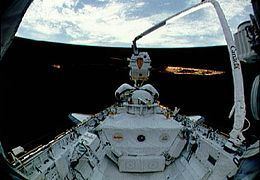Operator ESA SATCAT no. 22065 Launch date 31 July 1992 Inclination 28.5° Launch mass 4,491 kg | COSPAR ID 1992-049B Manufacturer MBB-ENRO Inclination 28.5° Period 1.6 hours Launch mass 4,491 kg | |
 | ||
Mission type Materials scienceAstronomy Mission duration Planned: 1 yearElapsed: 334 days Similar Olympus‑1, Artemis, ADM‑Aeolus, Cos‑B, HYLAS‑1 | ||
The European Retrievable Carrier (EURECA) was an unmanned 4.5-tonne satellite with 15 experiments. It was a European Space Agency (ESA) mission and the acronym was derived from Archimedes' bathtub revelation "Eureka!".
Contents
It was built by the German MBB-ERNO and had automatic material science cells as well as small telescopes for solar observation (including x-ray).
It was launched 31 July 1992 by Space Shuttle Atlantis during STS-46, and placed into an orbit at an altitude of 508 km (316 mi). EURECA was retrieved on 1 July 1993 by Space Shuttle Endeavour during STS-57 and returned to Earth. It was designed to fly five times with different experiments but the following flights were cancelled.
EURECA is one of the few unmanned space vehicles that have been returned to the Earth unharmed. It has been on display at the Swiss Transport Museum in Lucerne since 2000.
Configuration
EURECA was made of high-strength carbon-fiber struts and titanium nodal points joined together to form a framework of cubic elements. Thermal control on EURECA combined both active and passive heat transfer and radiation systems. Active heat transfer was achieved by means of a freon cooling loop which dissipated the thermal load through two radiators into space. The passive system made use of multilayer insulation blankets combined with electrical heaters.
The electrical subsystem was powered by deployable and retractable solar arrays together with four 40 amp-hour nickel-cadmium batteries. When EURECA was in the Shuttle cargo bay, power was supplied by the Shuttle. The modular attitude and orbit control subsystem (AOCS) maintained attitude and spacecraft orientation and stabilization. An orbit transfer assembly, consisting of four thrusters, was used to boost EURECA to its operational attitude of 515 km (320 mi) and return it to a retrievable orbit of about 300 km (190 mi).
EURECA was three-axis stabilized by means of a magnetic torque assembly together with a nitrogen reaction control assembly (RCA). Data handling was carried out by EURECAs data handling subsystem (DHS) supported by telemetry and command subsystems providing the link to the ground station.
Experiments
EURECA consisted of 15 experiments:
